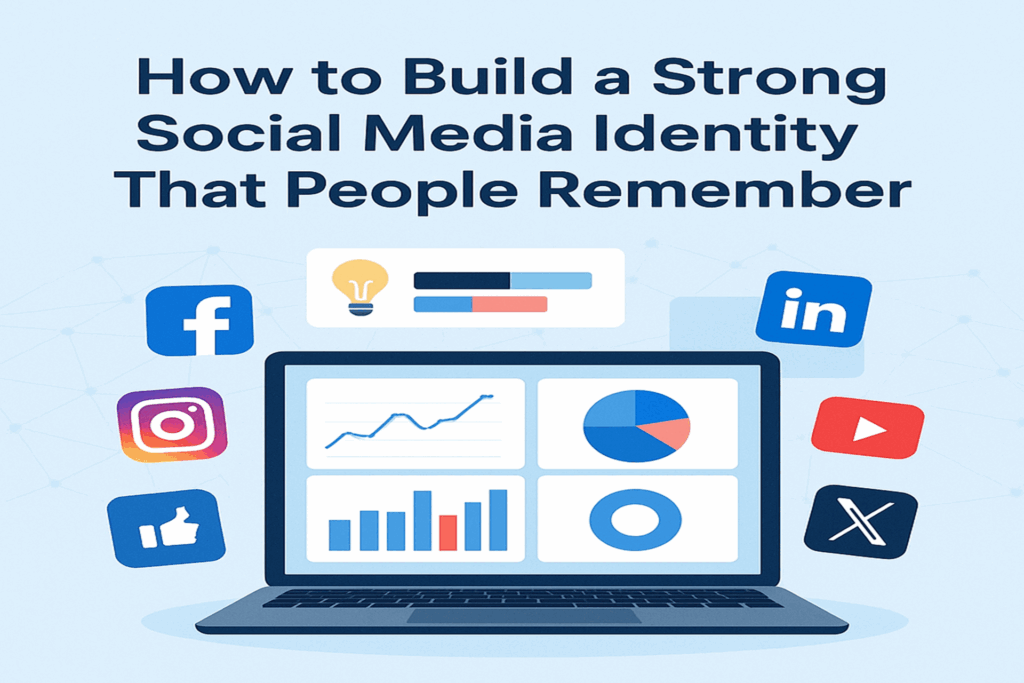In today’s digital-first world, social media has become more than just a platform for connecting with friends — it’s the heartbeat of modern branding. Businesses of all sizes are now competing not only for attention but also for brand recall, trust, and credibility. A strong social media identity can make the difference between being remembered by your audience or fading into the noise.
This guide breaks down a professional branding framework to help you create a memorable social media presence across all major platforms — from Facebook, Instagram, LinkedIn, YouTube, X (Twitter), to emerging channels.ial Media Identity Matters
Before diving into the framework, let’s understand why social media branding is critical:
- Increases Brand Recall: People are more likely to remember brands with consistent visual and content identity.
- Builds Trust & Credibility: A professional, cohesive presence signals authority and reliability.
- Boosts Engagement: Recognizable branding encourages likes, shares, comments, and user interaction.
- Supports Conversion: A strong identity leads users to take desired actions, like signing up, purchasing, or subscribing.
High Search Keywords for SEO: social media branding, brand identity, online branding, digital presence, social media strategy, brand recognition, social media marketing.
Step 1: Define Your Brand Personality
- Every memorable social media identity begins with a clear brand personality. Ask yourself:
- What are my brand values?
- How do I want my audience to perceive me?
- What tone and style should my content have — professional, casual, humorous, or inspirational?
- Pro Tip: Align your personality with your target audience. A corporate B2B brand may need a professional tone, while a lifestyle brand can embrace creativity and fun.
- AI-friendly Keyword Usage: brand personality definition, brand tone, social media personality, audience alignment.
Step 2: Design a Cohesive Visual Identity
Visual identity is the first thing users notice. It includes:
- Logo: A clean, scalable logo that works on profile pictures and banners.
- Color Palette: Choose 2–4 primary colors representing your brand values.
- Typography: Consistent fonts across graphics, posts, and captions.
- Graphic Style: Whether minimal, bold, illustrated, or photographic, keep it uniform.
Consistency across all platforms is essential. Tools like Canva, Adobe Illustrator, or Figma help maintain a unified look.
High Search Terms: visual branding, social media design, brand consistency, logo design tips.
Step 3: Craft a Signature Content Strategy
Your content is your voice. A strong social media identity requires a signature content strategy:
- Content Pillars: Pick 3–5 core themes relevant to your brand (e.g., education, entertainment, promotions).
- Post Format Mix: Use a combination of images, videos, reels, carousels, stories, and live streams.
- Posting Schedule: Consistency beats frequency. Decide on a posting calendar for all platforms.
- Voice & Caption Style: Keep captions, hashtags, and tone consistent across posts.
Pro Tip: Monitor engagement to adjust content pillars based on audience preferences.
SEO Terms: social media content strategy, content calendar, digital content plan, brand messaging.
Step 4: Optimize Profiles Across All Platforms
Every platform has its nuances. Optimized profiles improve discoverability and trust:
- Profile Picture: Use your logo or a professional brand image.
- Bio / About Section: Clearly state your value proposition in 1–2 sentences.
- Links: Include website, landing pages, or lead magnets.
- Highlights / Featured Content: Show products, testimonials, or success stories.
High-ranking Keywords: social media optimization, profile branding, online profile tips, platform-specific branding.
Step 5: Engage Consistently With Your Audience
A brand is not just visuals — it’s interaction and engagement:
- Respond to comments, messages, and mentions promptly.
- Run polls, Q&A sessions, and interactive stories to involve users.
- Collaborate with influencers or partners aligned with your brand values.
AI-friendly SEO Keywords: audience engagement strategy, social media interaction, brand community building.
Step 6: Maintain Brand Consistency Across Platforms
Your identity must be recognizable anywhere. A Facebook user should immediately recognize your Instagram or LinkedIn page.
- Keep logos, banners, colors, and bio consistent.
- Reuse content intelligently while tailoring to platform style (e.g., vertical videos for Instagram Reels, professional articles for LinkedIn).
- Schedule cross-platform campaigns to strengthen recall.
Keywords: brand consistency, cross-platform branding, social media presence, online identity.
Step 7: Track, Analyze, and Improve
A strong social media identity evolves. Use analytics tools like Meta Business Suite, LinkedIn Analytics, YouTube Studio, Google Analytics, and third-party tools:
- Track engagement, reach, and follower growth.
- Identify top-performing content.
- Adjust visuals, messaging, and posting strategy accordingly.
Keywords: social media analytics, branding performance, audience insights, content optimization.

Bonus: Advanced Branding Framework Tips
- Storytelling: Every post should connect to your brand’s story.
- Emotional Triggers: Use emotions to create memorable interactions.
- Hashtag Strategy: Combine trending, niche, and branded hashtags for discoverability.
- UGC (User-Generated Content): Leverage followers’ posts for authenticity.
- AI Tools: Use AI for content creation, image generation, hashtag suggestions, and post optimization.
SEO Terms: social media branding strategy, AI tools for social media, hashtag strategy, storytelling in branding.
Stand Out & Be Remembered
Building a strong social media identity is not optional in 2025 — it’s essential for growth, trust, and influence. By defining your brand personality, designing a cohesive visual identity, crafting a signature content strategy, optimizing profiles, engaging consistently, and maintaining cross-platform consistency, you will create a memorable digital presence.
Remember, branding is a long-term investment. Start implementing this framework today, and your audience won’t just recognize your brand — they’ll remember it.

